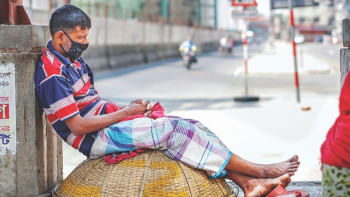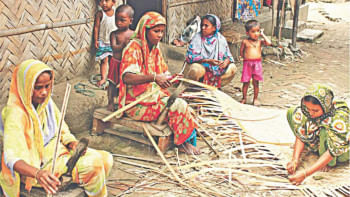How can we identify pockets of poverty early on?

Endeavours to reduce poverty do not usually have a uniform effect; pockets of poverty always seem to emerge. For instance, while developing countries have made remarkable progress in poverty reduction since 2000, 80 percent of the total extreme poor continue to inhabit the regions south of Sahara in Africa and those in southern Asia. Pockets of poverty prevail in middle- and high-income countries as well. Despite the welfare reforms in the United States, such pockets are increasingly found in its south and southeast states. The UN-Habitat also expresses its deep concern over pockets of poverty being an increasingly common feature in the cities of developed countries.
The history of poverty reduction in Bangladesh follows a similar trend. The incidences of moderate and extreme poverty in Bangladesh have been declining throughout the 2000s and, as of now, the extreme poverty rate in Bangladesh stands at 5.6 percent. But even so, at the district-level, there are a number of areas which have consistently found their place in the high-poverty lists referred to in several of the five-year plans. Looking at the massive amount of work on pockets of poverty from around the world and from Bangladesh as well, this article explores some common themes or factors that contribute to the formation of such pockets.
The major factors behind this include adverse climate, poor infrastructure for connectivity, low market access, distance from urban centres, susceptibility to natural and/or human-made disasters, low population density, insufficient economic and/or social services, low income, unfavourable agricultural environment, and hard-to-access geographical location.
If seen from a poverty reduction perspective, some of these may work as primary factors and some as tertiary factors in the formation of a poverty pocket. Primary factors play a causal role for the tertiary factors. The following diagram will help bring clarity in understanding the interconnectedness of these factors.

The interrelations of these factors are intricate. However, almost all the factors connect back to three points: remote geographical location, adverse climate, and poor infrastructure relating to connectivity. With these three being the primary factors, the rest can be considered as tertiary ones.
The Background Studies of the 8th Five Year Plan (FYP) of Bangladesh lists 20 districts as poverty hotspots in the country – five districts based on income poverty, 12 districts based on social deprivation, and three districts based on both income poverty and social deprivation. Many of these districts feature poor transportation facilities causing poor connectivity, particularly with urban centres. Some of the districts lying on the border regions fall in this category, which makes it difficult for other parts of the country to connect with them. Kurigram, for instance, has been listed in the 6th, 7th, and 8th of FYPs. Remote charlands, particularly those in Jamalpur and Sherpur, are another common theme in this discussion. The Chittagong Hill Tracts (CHTs) also fall in this category, where poor infrastructure makes transportation difficult to and from the rest of the country. This leads to poor market access resulting in a low level of economic services and also low income.
Bangladesh sits alongside six other countries on top of the index for those at risk for climate change impacts and natural disasters. The Global Climate Risk Index 2021 identified Bangladesh as the 7th extreme disaster risk-prone country in the world. Tropical cyclones, tornadoes, floods, coastal and riverbank erosion, droughts, and landslides are the major climate-induced hazards in Bangladesh, with different locations facing challenges typical to their geographic and climatic region. While chars, haors, and riverside areas tackle floods and riverbank erosion, the Barind Tract in the northwest is prone to extreme heat and droughts. On the impact of natural disasters on agriculture, researcher Binayak Sen characterised unfavourable agricultural environments as those that are salinity-prone, flood-prone, drought-prone and susceptible to river erosion. To cope with adverse climate impacts on agriculture, people in those regions need access to alternative livelihoods in the non-farm sector. But as opportunities for alternative livelihoods are very limited and connectivity is poor, people in the river erosion belts and in chars in the districts of Kurigram, Lalmonirhat, Gaibandha, and Jamalpur have remained among the extreme poor in Bangladesh over the decades.
A remote geographical location is at the heart of almost everything that has been discussed so far. Climatic conditions, connectivity, and everything else in the diagram can be connected back to geographical location, thus making it possibly the most important aspect in the formation of a poverty pocket.
Circling back to poverty reduction not being a uniform process, having an early warning system for spotting emergent pockets of poverty can be highly significant for the development agenda. To build such a system, identifying both primary and tertiary factors is crucial. Although primary factors can exist independently of tertiary ones, they have a decisive role in paving the way for tertiary factors to transpire. Tertiary factors are also highly influenced by different stakeholders such as the government, development organisations, and so forth. As such, the focus should be on identifying the tertiary factors while depending on the primary factors to direct us towards them.
But while all this can be a starting point for developing an early warning system for imminent pockets of poverty, further research and programmatic intervention from all stakeholders is indeed a necessity. A possible way forward is to allocate sufficient resources to design and implement a pilot for understanding how an intervention of this sort can be effectively developed. Surely, such a pilot would require the involvement of various agencies and interest groups. In the event that an early detection method of poverty pockets is truly modelled, the development journey of ending poverty in all forms can, in fact, take an important turn.
Palash K Das is director of the Ultra-Poor Graduation Programme at BRAC.
Tasnim A Ema is a programme analyst of the Ultra-Poor Graduation Programme at BRAC.



 For all latest news, follow The Daily Star's Google News channel.
For all latest news, follow The Daily Star's Google News channel. 









Comments